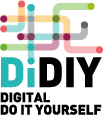Education

From primary schools to universities, Digital DIY technologies are already generating new teaching and learning approaches both in and outside the STEM (Science, Technology, Engineering, Mathematics) domain.
Investigating the link between DiDIY and education, it clearly emerged the different paces between technology evolution and the current formal educational structure, whereby the first unveils new teaching opportunities almost daily while the second lags behind, slowly absorbing novelty.
Innovating education is not possible without innovating teaching schemes. Awareness and participation of teachers is mandatory to share best practices and starting a virtuous cycle.
The DiDIY Project has studied the transformations that Digital DIY is already producing, or may produce, in European education and research, in order to produce guidelines that maximize the positive impacts of Digital DIY on the quality of such systems.
To understand this side of DiDIY, and what should be done about it, we suggest you to look at the following studies, proposals and other resources by the DiDIY Project, listed here from the least to the most complex:
FACTS SHEET(s) on: Introduction to DiDIY , DiDIY in education and research
DiDIY VOCABULARY KEYWORDS: Do It Yourself, DIY; Do It Yorself-er,DIYer, maker; Digital Do It Yourself, DiDIY; Digital Do It Yourself-er, DiDIYer; DiDIY competence; DiDIY knowledge; DiDIY tool; DiDIY material; DiDIY service; DiDIY codesign process; DiDIY platform; DiDIY education ; DiDIY teaching; DiDIY teacher; DiDIY learner
VIDEOs:
- DiDIY Final Conference: Digital DIY, Education and Research (in Italian)
- Digital DIY in Education- DiDIY Community Day, Barcelona
The parts of the DiDIY Guidance Manual about:
- Education and research (p. 29)
- Promot universal, basic DiDIY knowledge (p. 68)
- Guidelines for the main DIDIY stakeholders - Educatiors, education policy makers (p. 94)
Examples from the DiDIY POLICY PATTERNS wiki:
- Close format school teaching
- Educational systems' inertia in embracing new forms of education
- Finding resources to implement DiDIY in schools
- Lack of attention to ethical aspects in the new learning environments
- Old assessment schemes for new learning environments
- Schools cannot easily access external fablabs
- Students resistance in adopting a novel attitude towards learning
DiDIY Project Official Deliverables:
- Research space and agents
- Integration of background knowledge
- Methodological plan
- Results derived from data collection and analysis
- Strategic Plan
- Ethical issues in education and research
- Creative design and education and research
- Integrative modelling (Research and education)
- DiDIY-related education processes
DiDIY KNOWLEDGE FRAMEWORK:
DiDIY: a human-centric phenomenon; LW1. DiDIY and individual motivations; LW3. DiDIY and critical thinking; LW4. DiDIY and collaboration; LW7. DiDIY and outcomes; LW8. DiDIY and state-of-the-art technologies; LW9. DiDIY and cheap resources; LW10. DiDIY and co-design process; IW5. DiDIY and education; IW6. DiDIY and research; IW7. DiDIY and creativity

